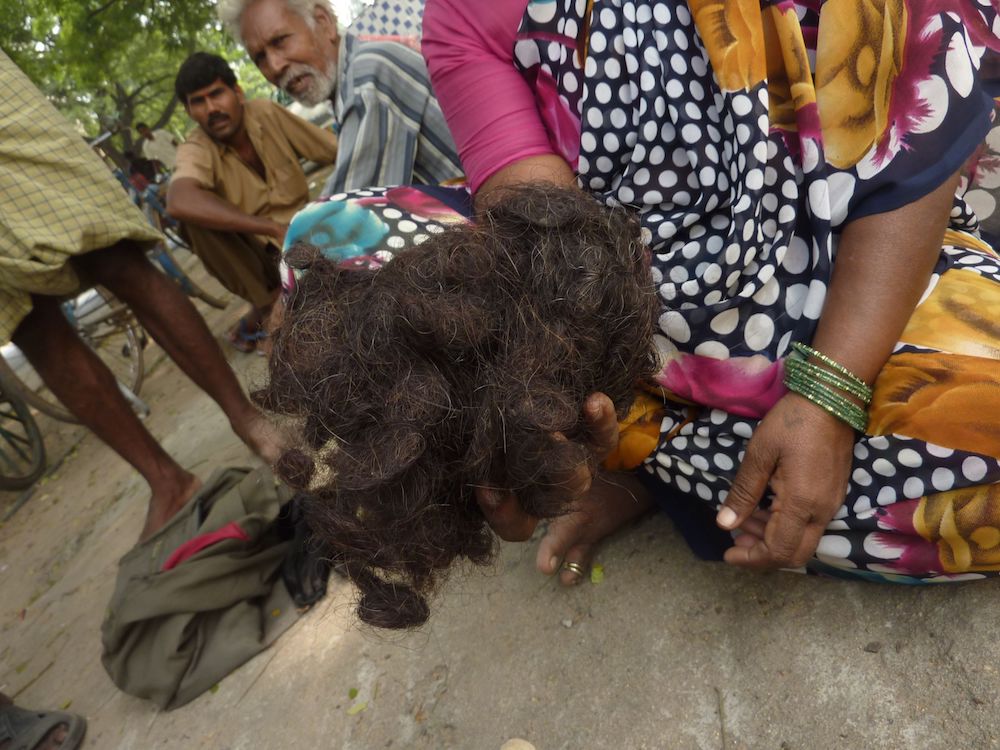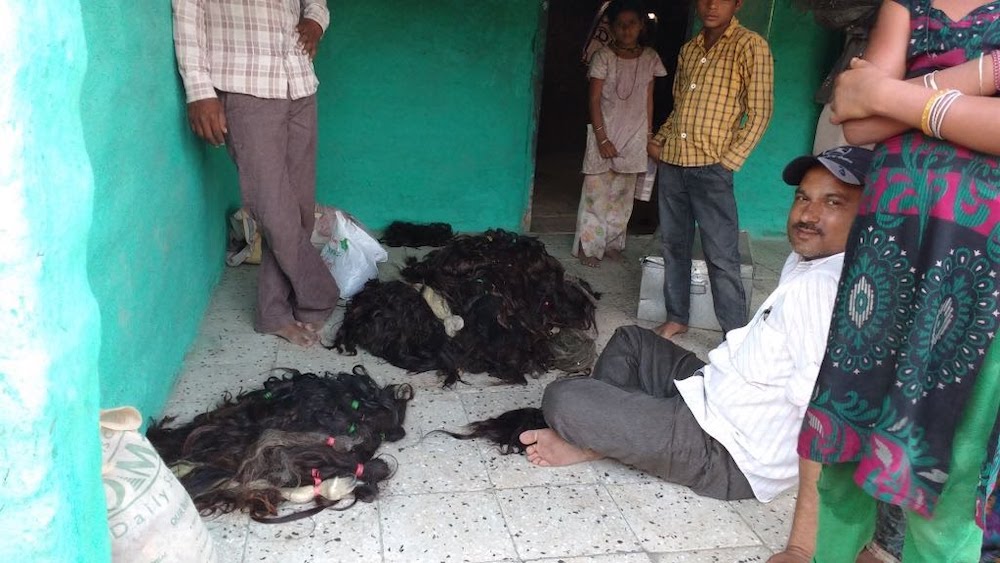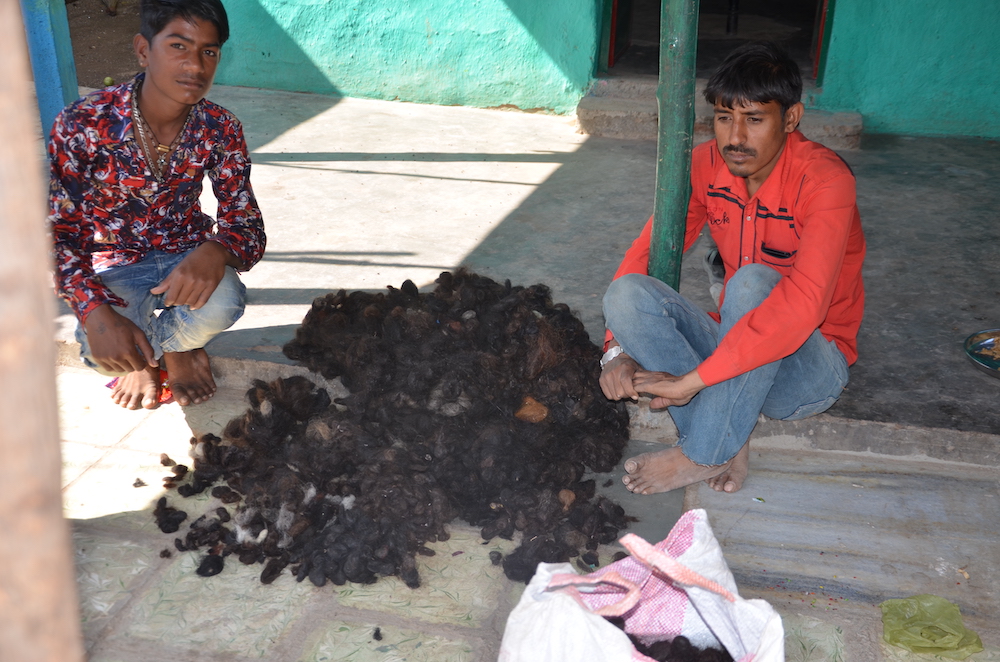The Hard Labor That Fuels the Hair Trade

Every evening, for two to three hours, people from the Waddar community gather in a corner of the Ganganagar marketplace in the city of Nagpur in central India. The area is severely impoverished; dwellings are assembled with bamboo sticks and tarpaulin sheets.
In the market, about 15 men sit on string cots pulled out from their nearby homes. Women from the family make themselves comfortable on their torn quilts or plastic sheets laid on the muddy ground. Toddlers run around their parents with unclothed torsos, while their teenage sisters take charge of polythene bags filled with waste human hair.
These strands come from combs, shower drains, and waste bins; they are the bunched and snarled tresses that many people discard without further thought. But in Ganganagar, they are precious. Waste combings are a prized commodity, enabling families to put food on the table.
Women in low-income households gather and keep this hair to sell to hair collectors. A 500-gram hair ball, for example, which may represent one to three days’ collected combings, might yield 500 rupees (about US$7). The buyer pays half upfront and promises the rest if the seller returns in the future with more hair. That amount could help a woman buy not only cheap housewares, such as a plate or spoons, which she can trade later, but also a day’s worth of milk and vegetables.
Families collecting comb waste in Nagpur and elsewhere in India have a hand-to-mouth existence with their meager earnings. Little do they know that the hair they sell takes on another life once it passes out of their hands, potentially gaining immense value as it travels the supply chain.
As many consumers can attest, buying a hair piece—whether wigs, weaves, extensions, or toupees—can be an expensive prospect. But few people know the sources for these products.
Scholars who study the hair trade would argue that ignorance is no accident. “Hair may be coming from people who are poor, or who may have different hygiene standards, so it is in the interest of the trader to keep the source invisible,” says British anthropologist Emma Tarlo, an emeritus professor at Goldsmiths, University of London.
Tarlo, a curious, passionate scholar, has spent years researching clothing, identity, and politics. She has studied the global hair supply chain, which crisscrosses the world. Her work reveals how people collect and sort strands in India, China, and Myanmar, then send hair on to wig and extension manufacturers in China. The final product may be sold in Europe, North America, or Africa, as she documents in her 2016 book, Entanglement: The Secret Lives of Hair.
While the hair trade is legal, it is entirely unregulated, and there are many murky ethical areas. Some companies mix animal and synthetic fibers with human hair, selling it as 100 percent human. And the people gathering and untangling hair often live in extreme precarity. “Cheap labor traces poverty around the world,” Tarlo notes, “and a workforce willing to do labor-intensive work for very little pay is available in Myanmar and other Asian countries such as India and Bangladesh.”
Globally, the industry is worth more than a billion dollars (more than US$200 million in India alone), and India is the second-largest exporter of human hair after Hong Kong, according to Statista. The majority of India’s export is waste hair, like the strands traded in Ganganagar.
In recent years, social and cultural anthropologists have documented and detailed the hair trade’s complex journeys and the lives it touches, particularly in India, which has held a longstanding role in the industry. Their work reveals both how this trade relies on the exploitation of vulnerable communities to supply the rest of the world—and how keeping these laborers invisible has enabled a deeply unequal system.
Of all the hair that India exports, the most famous comes from temples in Tirumala, in Southern India. Since at least the 1580s, pilgrims have shorn their locks before entering the sacred spaces of Hindu temples in the region.
Temple hair is highly regarded in the international market for being “remy,” that is, hair with its scaly cuticles intact and aligned from root to point. Though remy locks can come from other sources, too, such as barber shops, hair donations, and people selling their hair to charities, the ones from temples are among the most desirable in the trade.
Both men and women give up their hair, but many coveted strands come from the heads of rural Indian women who oil their hair and grow it long, a symbol of femininity and beauty in their circles.
At the highly organized tonsuring halls at temples, licensed barbers snip away tresses that took years to grow. The length, lack of chemical hair treatments, and compatibility with European hair textures make companies across the world “ferociously compete” for temple hair, Tarlo notes.
Venkateshwara, the largest hair-generating temple in India, makes claims to being the second-richest religious institution after the Vatican. It holds an e-auction of hair every few months. During one such auction in 2019, the temple earned 7.94 crore rupees (more than US$1 million) by selling 4,300 kilograms of hair.
But demand far exceeds what Southern India’s temples can supply. Instead, the vast majority of locks are “discarded combings, which form about 70 percent of the Indian hair export,” Tarlo estimates, even as factories use the reputation of quality Indian hair to market strands coming from India. Entangled waste hair combings do not last as long as remy temple hair, as their cuticle layer is stripped to reduce tangling.
In marked contrast to the careful tonsuring of devotees at Tirumala’s temples, waste hair picking and collection is not a tidy business. For example, in Northern Indian cities such as Varanasi, Assa Doron, a professor of anthropology and South Asian studies at the Australian National University, has documented how young boys—Muslim migrants from an impoverished area—gather discarded hair from the roads and gutters in the city.
In his 2018 book, Waste of a Nation: Garbage and Growth in India, co-authored with historian Robin Jeffrey, Doron writes that so precious was waste hair for them, that, once back home, the boys carefully segregated every strand from the refuse they picked on the way.
Not all collection occurs on the streets, however. Anthropologist Dipti Bapat, who works with several Indian government projects in New Delhi, has gotten to know waste hair collectors from the Waddar and Vedhwa Waghri communities, two of the country’s Denotified Nomadic Tribes who gather hair through a trade system.
India has hundreds of recognized nomadic, pastoralist tribes—of which about 200 are “denotified,” meaning they are members of communities that British authorities criminalized in the 19th century. Today these communities remain stigmatized and subject to police brutality. They lack adequate government support, education, and professional options beyond hair collection.
The Waddars and Vedhwa Waghris travel into low-income areas and exchange goods, such as cheap utensils, toys, or sweetmeats, for the hair that individuals and families save up. To avoid police harassment, they trade in unguarded areas such as large tenement buildings and self-made encampments.
Though they can work for up to 12 hours each day, these collectors make very little, Bapat has found, earning a fourth of the minimum wage of a central government construction worker or a cleaner, for example, and definitely not enough to support the typical four to five dependents, even when both partners work. In addition, though some collectors gain upward mobility—like a buyer in Nagpur who told Bapat of how he rose the ranks from being a hair collector’s son—many rely on begging for additional income.
The Vedhwa Waghris who Bapat has worked with live in makeshift houses without floors, doors, or ceilings, erected out of tarpaulin sheets, rags, wooden sticks, and quilts. Female hair collectors walk for miles, often barefoot and carrying children, in anticipation of a good exchange. “Most work right up to the end of their pregnancy,” Bapat adds.
Men meanwhile may travel farther, on a bicycle, bus, or train. They journey for weeks, sometimes without proper food, spending nights on railway platforms or pavements, carefully guarding their collection from theft on their way back.
Other forms of waste collecting and selling exist in India—notably millions of ragpickers who search refuse for leftover foods, glass, plastic, metal, and clothes that they can trade. Hair pickers, like ragpickers, are service nomads and make a significant contribution to the recycling industry, Bapat notes.
But the position of hair pickers and collectors is distinct from these trades in part because of the leaps in value that hair can gain as it journeys up the supply chain. Doron traced hair sold by young Muslim men to an intermediary, then a wholesaler, then a small factory, and then to exporters who run large factories. “Throughout the waste chain,” Doron says, “the value of hair can increase exponentially, at times by 50 percent, at others by far more.”
As hair changes hands, it may be treated in ways that enhance value. At factories, for instance, men and women measure hair for length, run it through purpose-built combs, remove lice and gray strands, and sanitize the hair with chemicals before packing it up for export.
But many jumps in value are pure profit. Some buyers informed Bapat that they sold hair to a dealer for double the price they purchased it for from the hair collectors.
To explain this system’s inequity, anthropologists who have studied the hair trade note that the waste pickers’ role is hidden in many ways. One of the reasons for this obscurity “is the highly dispersed trade and the informal nature of their job,” Doron explains.
Indeed, one of the award-winning traders Doron met in New Delhi sold 60 metric tons of waste hair a month to international markets, claiming himself to be the largest exporter of raw waste hair in India. According to Doron, his company did not purchase any temple hair. Instead, it sourced hair from hundreds of thousands of freelance waste hair pickers through intermediaries.
With a more than US$200 million industry, India is the second-largest exporter of human hair—much of which comes from waste.
Factories are not sharing their sources or process, Tarlo notes, both to remain competitive and avoid any messaging that might deter buyers put off by waste hair from impoverished communities. Even within the supply chain, secrecy is maintained at all levels.
Many intermediaries run unregistered enterprises in the informal sector of India’s economy. Bapat found that hair pickers and collectors are wary of discussing their work. “Owing to cheaply available labor, the comb waste collectors knew they were replaceable, so giving out their trade secrets and sources to anyone outside the community would have cost them their jobs,” she says.
Such secrecy ultimately makes it easier to exploit laborers at the bottom of the supply chain. Not only do they receive a fraction of the payments associated with the hair they collect, their work can be physically taxing. The labor of hair collectors and sorters, including factory workers, is repetitive and monotonous, taking its toll on backs, eyes, and lungs.
Women, in particular, are disadvantaged. “The gender bias in the hair trade is striking,” Bapat says. Among collectors, it is women who walk seven to eight hours a day with their kids and untangle the hair at home. At factories, women are in charge of intense and lengthy processes such as sorting and cleaning strands. Men tend to do either easier jobs, such as packaging, or more lucrative jobs, like running the companies, says Tarlo, who found this trend around the world.
Bapat began studying the waste hair collectors’ plight as a graduate student at the Central University of Hyderabad. After years of getting to know Waddars and Vedhwa Waghris collecting hair, she now has an opportunity to make change in their lives.
Today Bapat works with the National Urban Livelihoods Mission, a government program that aims to assist some of the nation’s poorest communities. Starting in January 2021, as part of the PM SVANidhi project to benefit street vendors, Bapat has contributed to an ongoing pioneering survey of sellers across the country.
Every respondent to the survey becomes part of a central database, which the government will use to link them to welfare schemes, including insurance, pension, and maternity benefits. At Bapat’s behest, waste hair collectors have been added to the survey, giving them the recognition of street vendors and raising them from obscurity.
Bapat says that revealing the position of waste hair pickers and collectors in the supply chain could bring to light their work’s value to the industry overall. With that knowledge, they could bargain for a better income. For that matter, if factories openly acknowledged their sources, hair collectors would have greater power in the system. They could, for instance, set up small independent shops to formally sell to various buyers, she says, or organize into cooperatives.
Put simply, if secrecy enables the trade’s exploitation, transparency—revealing the stories and experiences of these otherwise invisible laborers—could offer a solution.
































